Chef Anumitra Ghosh Dastidar’s Home-Grown Adventure
For the co-owner of Goa’s Edible Archives, the mundane bottle gourd deserves the same culinary riffing as the now-trendy amaranth; in her kitchen, every ingredient is king, nurtured by the context of the earth from which it came. The affable chef spends a day with Verve and orchestrates a market-to-table experience that has her inimitable stamp
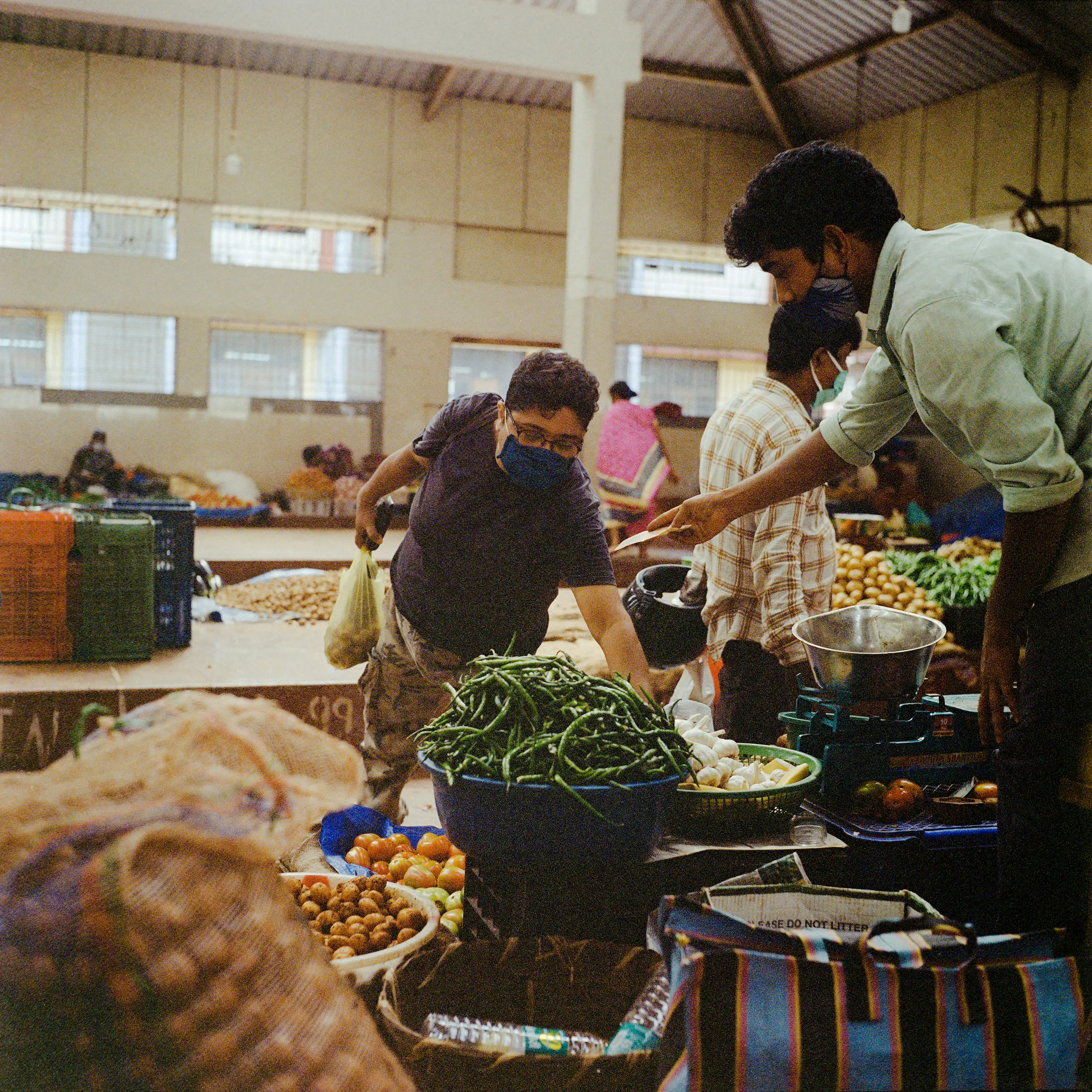
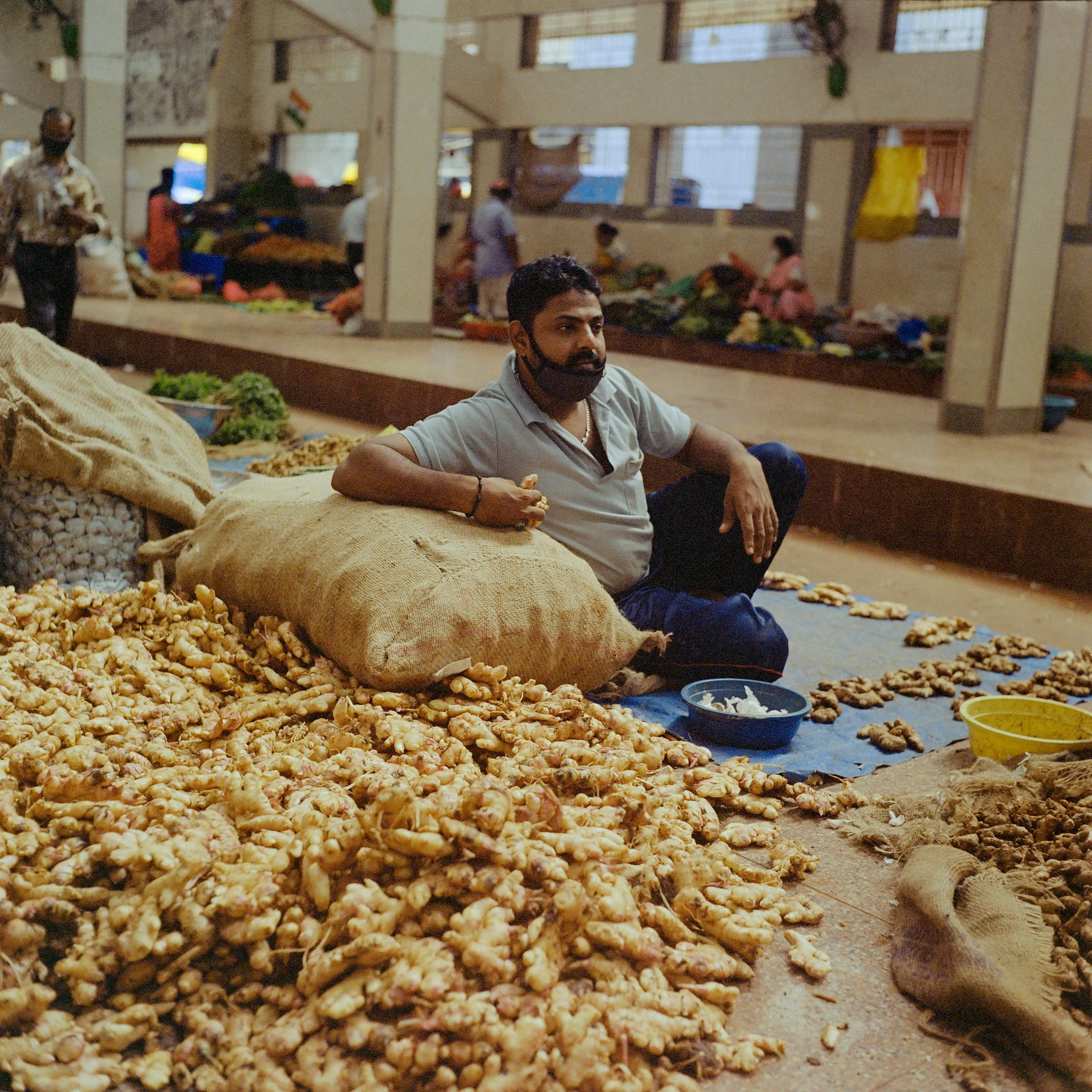
At the Mapusa morning market in Goa, Chef Anumitra Ghosh Dastidar pauses near a long tuber with tough skin. The vegetable had made her stop her otherwise fluid choreography through the market, in which she moves between fish stalls and vegetable sellers as if in a music video – arms reaching for fresh greens, questions being asked to vendors about their catch. The rest of us (the photographer Tenzing Dakpa, his assistant Brita Boruah and I) have flung ourselves through the market’s reaches, pointing to the different produce that resonates with our childhoods, buying plump stalks of ginger and shouting things like “Look at this round, green lemon!” across vegetable sellers, some amused and others annoyed with the noisy bunch that had suddenly entered their market. It is a sleepy day, but the marketplace is alive in bright Technicolor. Large stalks of green spinach nestle in black plastic baskets. Fresh fish with swollen eyes sit invitingly among the regulars who come for tea and a chat, and not only purchases. The ice between us has been broken, mostly credited to Dastidar’s tranquil, easy manner of inducting people into her world. Her persona is ageless, a mix of excitement and wisdom that animates our whole day. An hour ago, when we met, she made polite conversation outside the gates of her restaurant – mentioning to the photographer that she had seen his work, rattling off vegetable names in Assamese to his assistant and talking to me about her time in Delhi.
Dastidar takes slow steps through the market’s expanse, stepping off her path to ask questions about a certain red spinach, which I later learn is the now-trendy amaranth, or wondering out loud why small potatoes don’t sell as much as large ones. “This is madi, she instructs patiently as if she is our guide. This has been her demeanour throughout; on the drive here, she had guided our route manually, telling me to put my phone away and enjoy the view. “Anyway, Google doesn’t know,” she had smiled as she asked us stories of our childhood. “Take a right from here. And look on the left – that is Xavier Cafe. Great beef cutlets,” she said, getting us excited at the prospect of the bakeries we would visit later, urging us to go from strangers that had just met to friends making plans for a beer and snack.
“So what do you think – should we cook it?” she asks about the tuber as I take notes and the others rack their brains to decide on this vegetable that they don’t recognise. “Is it a yam?” I ask, redundantly, and she nods patiently. “Yes, but a different kind,” she explains, choosing to buy it and ignoring us while we scramble for our wallets. She thanks the seller and holds the large cylindrical madi across her shoulder like a light log of wood. “Look there, taro leaves,” she says, as we begin to walk. “And look that side, pumpkin flowers.” We turn to look at the things she is pointing at, her keen eye noticing native Goan vegetables tucked between stalls and others that peek under the more dominant cauliflowers, which she calls “bland”. As we leave the market and walk outside, we scatter again, rummaging for face masks, lamenting the pandemic and poking through trinkets and wondering out loud how much it takes to repair a smartphone screen in Goa. Dastidar waits for us at the road corner, eating a samosa, deep in thought. “So this is done,” we hear her say. “Now tell me, what else would you like to eat today?
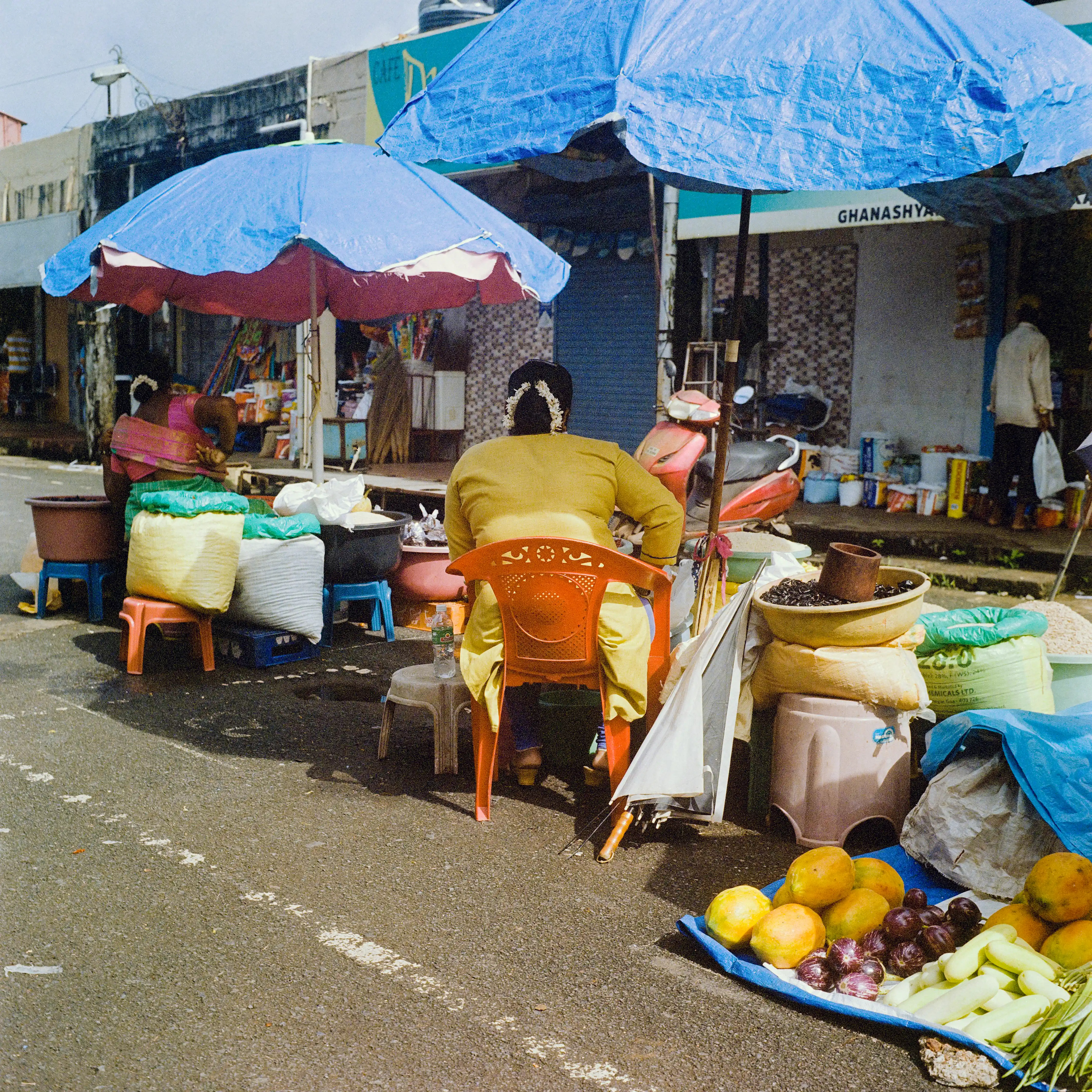
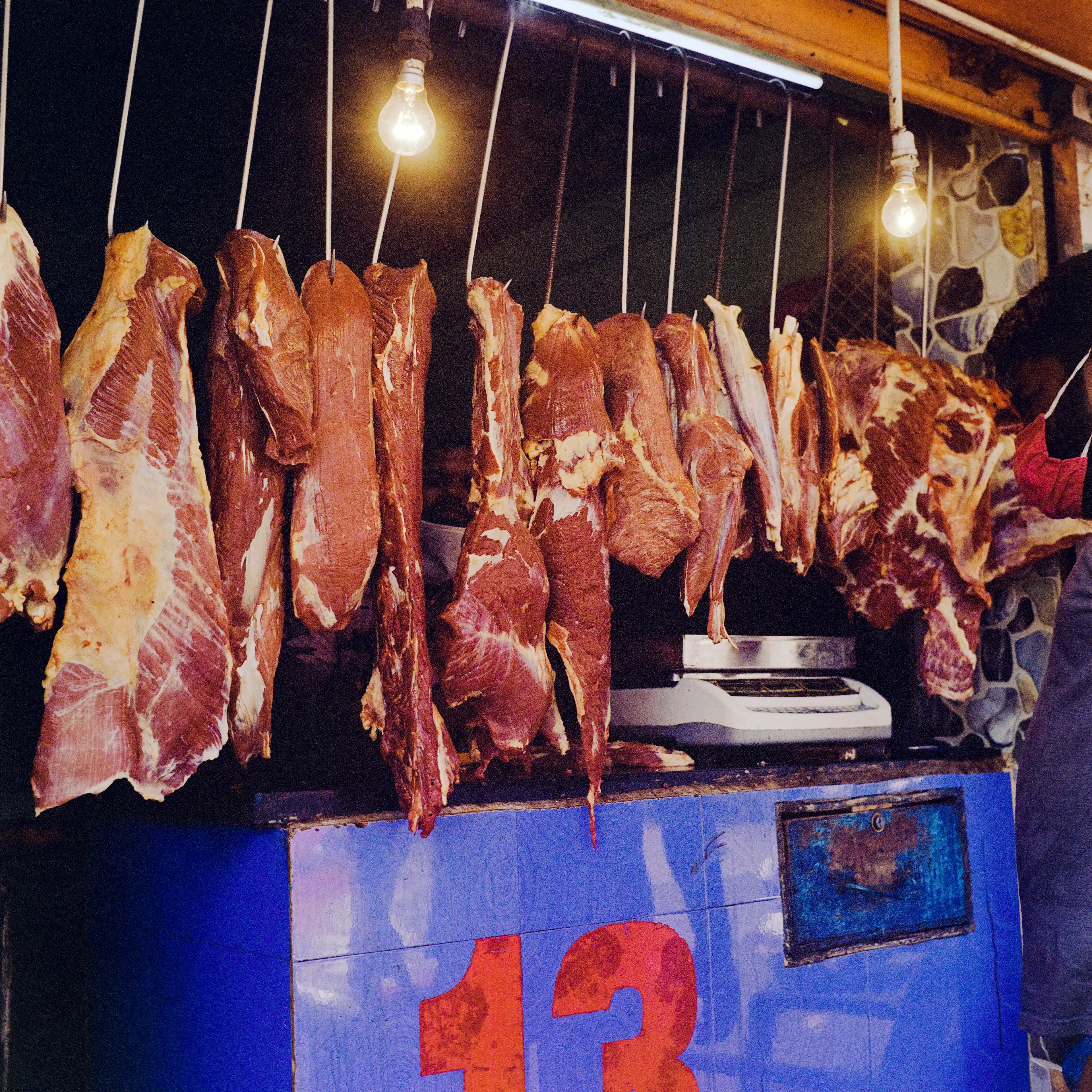
Dastidar is the chef at Edible Archives, a research project and restaurant that she and her partner, Shalini Krishan, opened in November last year and run together. The duo began their journey toward the restaurant with a project they presented at the Kochi-Muziris Biennale in 2018; the project catalogued and profiled 40 varieties of indigenous rice grains from Kerala, which they had been researching for almost three years. The restaurant, where the food is not separated from the farms and communities from which it is sourced, combines a keen anthropological eye with ardent technique that “is ingredient-driven, in an age of climate change and rapidly depleting biodiversity”. The set-up aims not to detach food from climate, culture and contemporary social change but instead to use a plate of food to spark a conversation, or communicate a context about the same. Before they closed, the menu comprised dishes such as caramelised plantains with pistachios and ice-cream and Shaanxi-style brinjal and long-bean stir fry where “Goan vegetables took on a Chinese avatar”. The focus is on using ingredients that are not market-driven and disrupting the monochrome of produce that is usually on offer. Edible Archives aims to push their clientele to think about native seeds and produce indigenous to Indian soil. Apart from this, they also serve different varieties of rice from around the country, which Dastidar cooks in risotto and puddings for dessert. “Rice is seen as something that is the side of a meal, but it is not so,” Dastidar says, Her palate understood the diversity in rice varieties before she became a chef. “Rice grains have the wisdom of generations,” says Dastidar. “But we [Indians] eat mostly hybrid seeds pushed by the state.”
The restaurant is located in a Portuguese-style house in Anjuna, tucked behind a busy main road and a large bus stop in front of a small body of water, which some teenage boys run and jump into as we arrive with our shopping for the day. It is a picturesque affair; a large knobbly gate opens up to a large garden, and the grey villa exposes itself with neat wooden fences and windows that look like those built into Lego homes. Dastidar and Krishan found the house through a friend. “We loved it,” says Dastidar, leading them to immediately renovate between May and November last year. Just as the spot had begun to gain momentum, it had to close its doors in the face of the COVID-19 pandemic. “It has been a difficult time,” Dastidar admits. “I had to scale down, and since the restaurant had not been running long, there were no profits. The investment we had made to open was not met very soon,” she says. “We are operating a takeaway model for now,” she said. “Maybe we will open later, but for now, there is no way I am putting my staff in danger.”
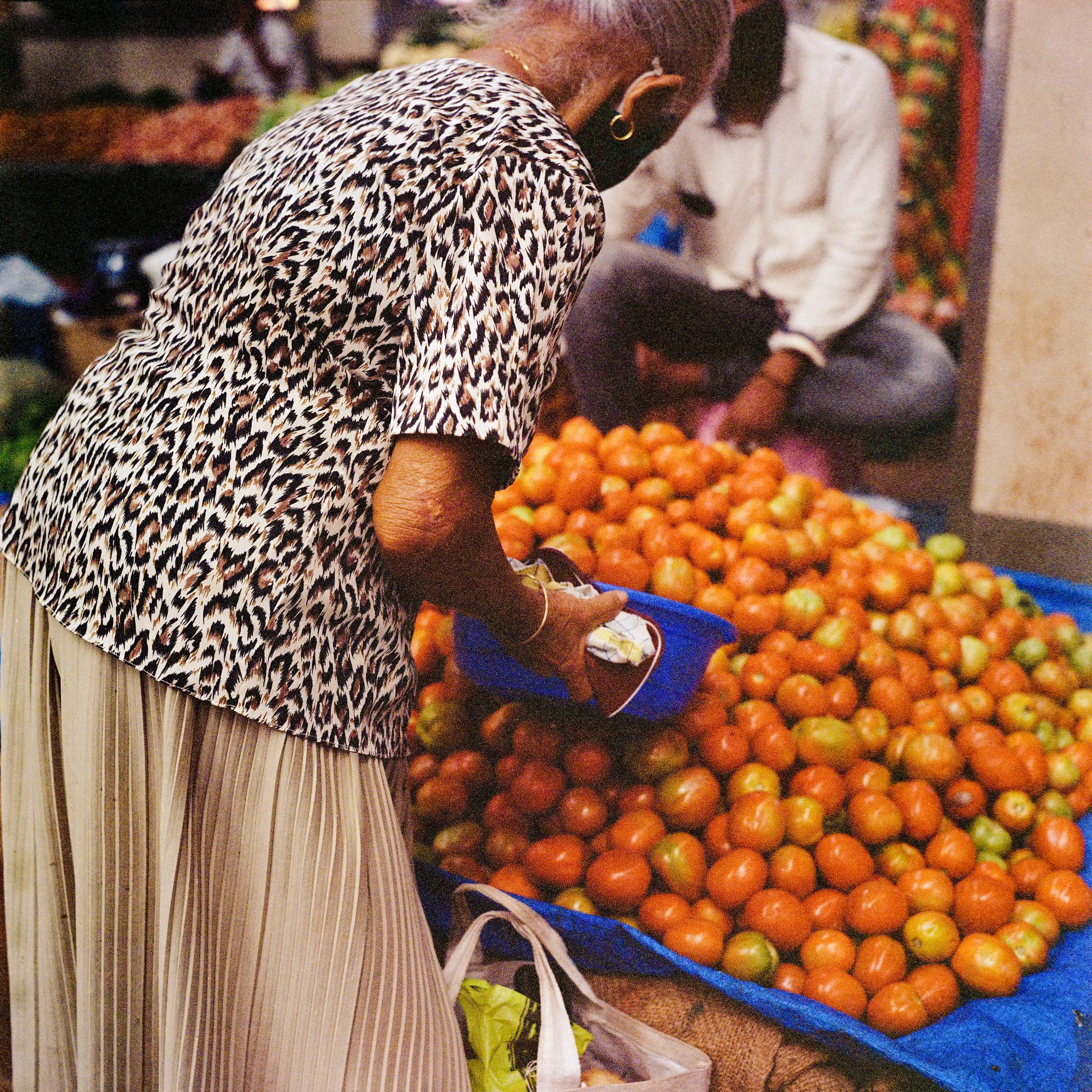
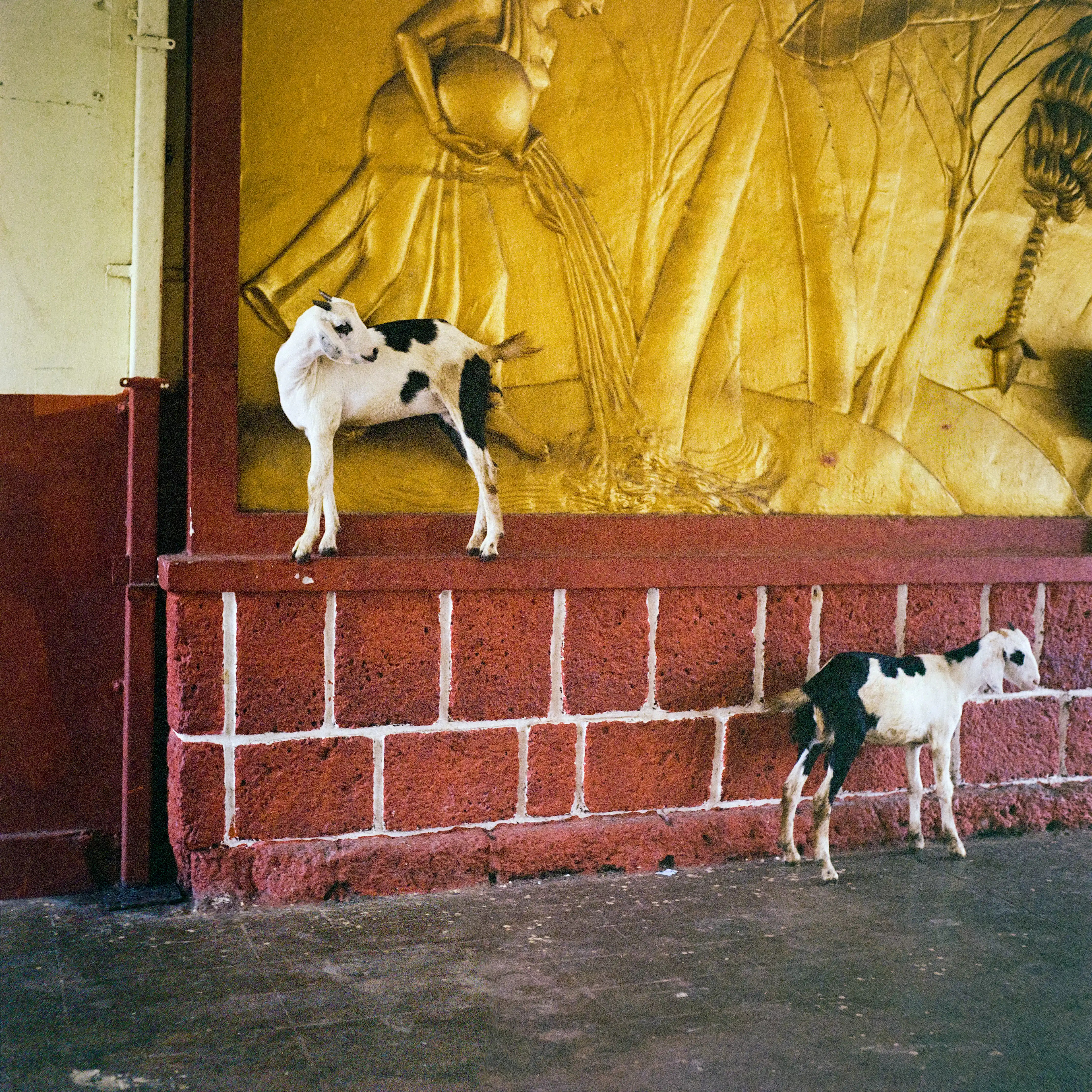
Even as Dastidar now lives in Goa, she grew up in Kolkata, in a family of “at least 20, at one time”. Before her career as a chef, she studied for a PhD in Cognitive Linguistics in New Delhi, alongside which she got her start in a kitchen with Chef Takayaki Tamura. “I was hired as a dishwasher, but that is how I learned,” she says of her time in Tamura’s restaurant, called by the chef’s name. After working with Tamura, Dastidar went on to start Bento Bong, a Japanese-style bento box delivery service, and pop-up that served Bengali food and also began her restaurant Big Bong Theory in South Delhi. This was when Ritu Dalmia, the head chef at India’s best known Italian restaurant Diva, came to dine at the latter and asked Dastidar to join her team. As we walk past the signboard for her restaurant, Dastidar keeps the conversation going, talking about cooking all over the world and learning techniques from chefs of different origins. She leads us to a small room that she calls “the office”. When we enter, she takes off her shoes and puts a mattress and two chairs out between a bookshelf and a table on which sits a glass pot in which she starts to brew tea. It is a comfortable setting; we welcome it after the morning at the market. Dastidar arranges her books before she sits down to talk.
“I already had a large vocabulary of ingredients and foods from my upbringing in Bengali food. But when I learned to cook different cuisines, it was like parts of my brain lit up,” she says. “That is what travel does, I suppose, open your brain up to possibilities you may have known but not yet understood.” But, Dastidar reiterates, it is really from her “Bengali roots” that her journey in food grew. “From the very beginning of my life, I was exposed to good food,” she says, speaking of the meals she ate at home, which her family, an upper-caste one from East Bengal, would cook. “They used a lot of rural ingredients,” she says. “But we were a Calcutta family, so I was also exposed to the foods of the city,” she adds. She mentions her fondest memories from childhood – biryani cooks in Kolkata that her father would offer patronage to, “basic cheese” that was brought by distant relatives, which she loved as a child. When I ask her to name the dishes she grew up eating, she says, with a playfulness that we have become accustomed to, “Let’s play a game. You tell me an ingredient, and I will tell you eight things to cook with it.” She pours tea for us into small cups without handles that everyone reaches for earnestly, after which she rolls a cigarette slowly and leans on one elbow, waiting for me to begin.
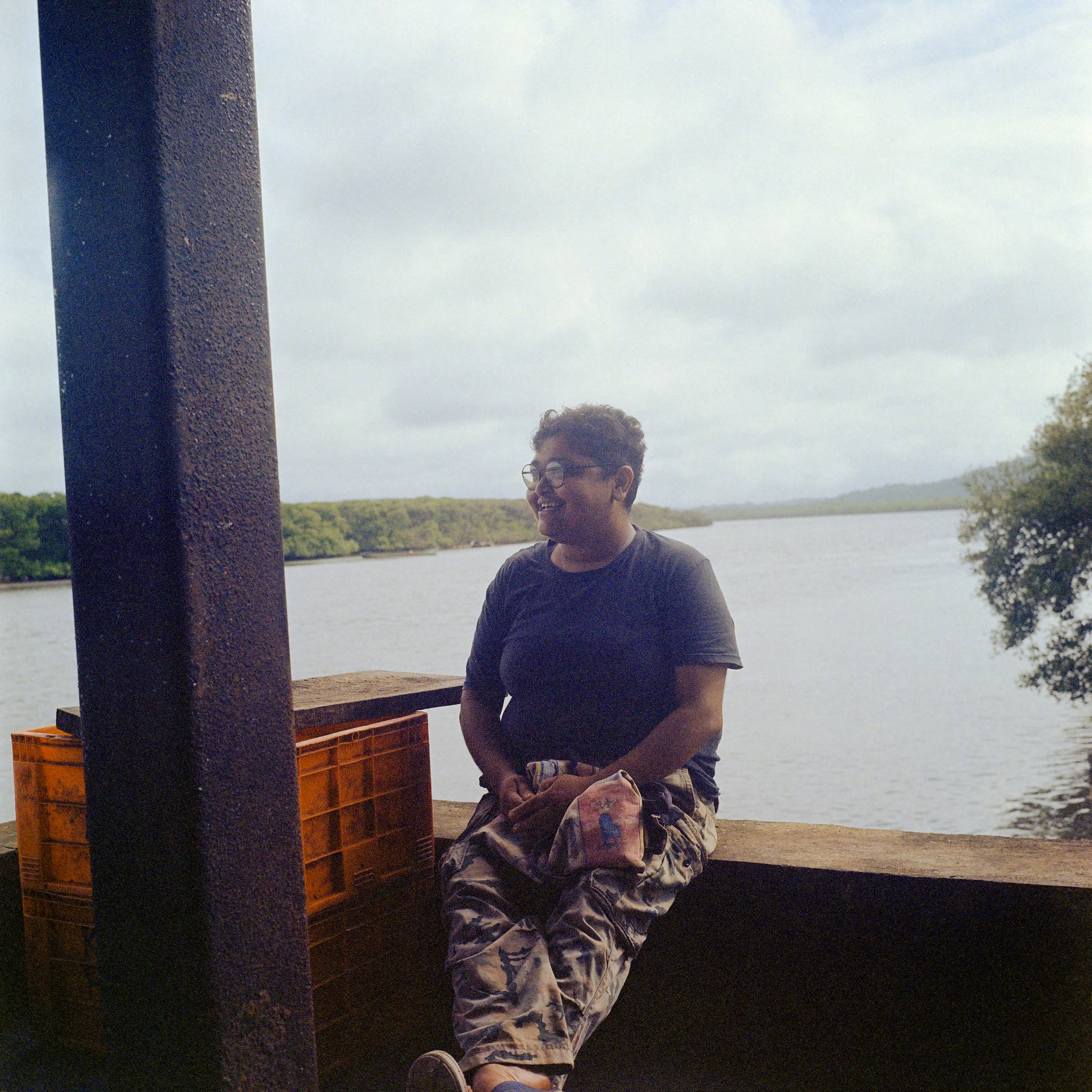

“Yam?” I say, after a long pause. Unlike Dastidar’s, my vocabulary for vegetables is limited, and I predictably jump to the vegetable we had bought earlier in the day. “So which one? Elephant foot, or snake yam. Or sweet ones?” she asks. “Just regular?” I say, and she sits back, takes a drag from her cigarette, offers me one and begins. “Yam with mustard oil and lemon,” she says, “yam cooked with a little bit of ginger, yam with pork, and yam – you can cook it with dried fish as well.” She rattles off a line of recipes. “One of my favourites is to make thin yam slices, roast them and eat them as yam biscuits,” she says. “Or yam lightly sautéed with soya sauce – this is something they do in Japan,” she says. “So good,” Dakpa says as if imagining the dish in his mind. “These sound so simple!” I interject, and Dastidar nods, but disagrees. “These aren’t that simple, the difficult thing is balance,” she says. “We take this stuff for granted, but there is technique behind it. There is great wisdom in the everyday chatter that goes on among women in kitchens.” She switches from yam and tells stories of the spinach leaves that formed her family’s table. She mentions taro greens, or kochu-shak made with fish head, she talks about phaina bhat, a Bengali rice congee, which her grandmother used to make. Distracted and engrossed in her stories, we have forgotten about the tea, which we drink as she instructs us, “Help yourselves, stretch out”, before slowly sipping from her own cup. “You’ll have to excuse me; I have to go to the kitchen,” she says, after we talk about edible creepers, recipes with dried fish, pork fat tempered into perfection, shiitake mushrooms from Bhutan – the best ones she ever ate. “I wonder,” I begin, as she gets up to leave, “If we have all this, then why is there no pride in it? Why do we try and aspire to Western food, Western vegetables?” Dastidar pauses in her characteristic way, ready to give me an answer before she goes to her stove. “This is a complex question, but you said the word. It is “aspiration”. It is not about what you have. It is about what you want to be.”

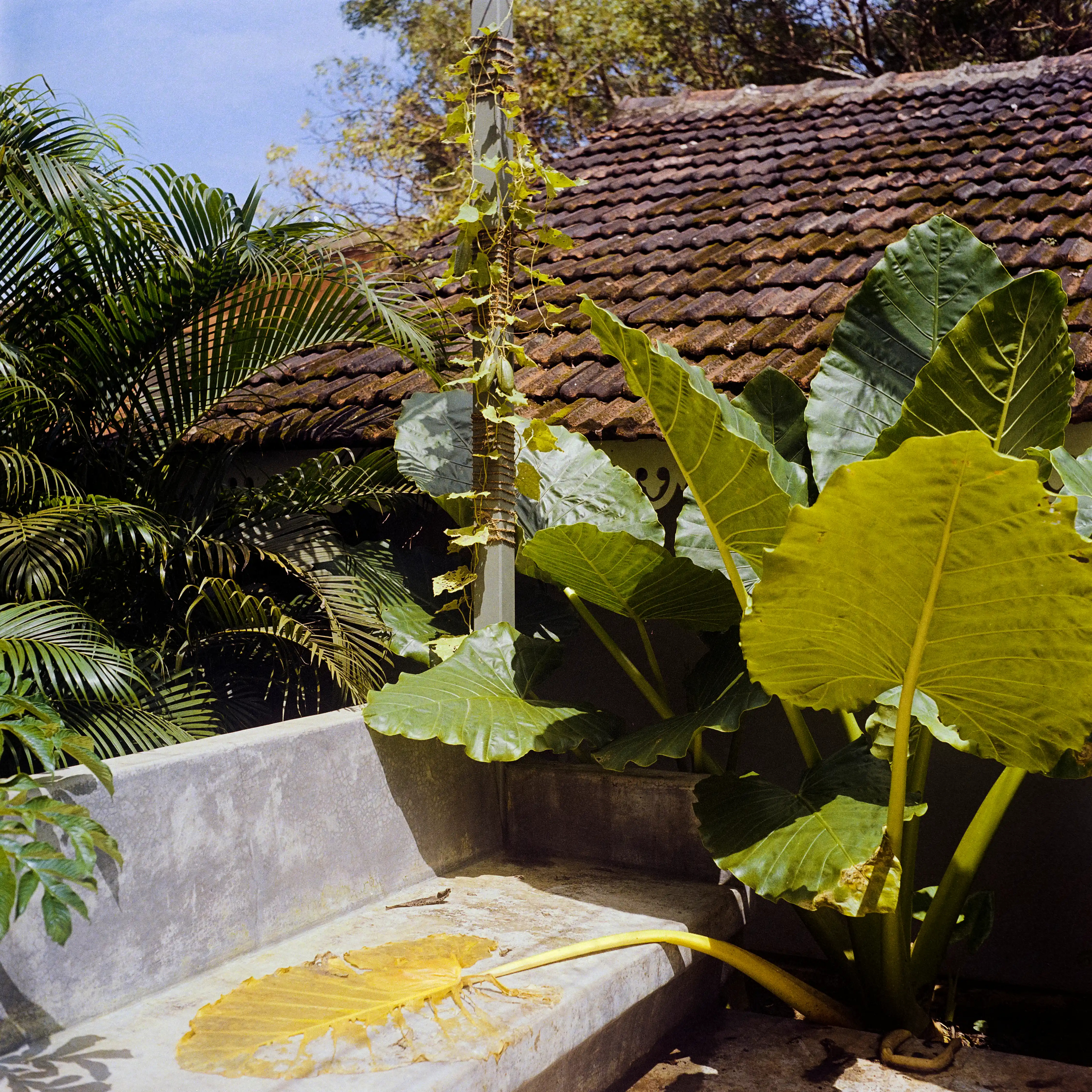
When she returns from the kitchen wearing a black apron, she has changed into a comfortable lungi from her pants. She finds the rest of us talking about Assagao, the neighbourhood close to hers that has become a hot-spot for boutique hotels, plush yoga studios and swathes of wealthy migrants who arrive in Goa for blue skies and cheaper rent. “Did you know Assagao ran out of groundwater some years ago?” She chimes in while standing in the doorway, referring to the number of swimming pools being built in what was once a village. “Let’s go to the garden,” she says as we finish talking. “I have been waiting to do that all day.” On the way, we pass a large open space with a meshed ceiling. This is Edible Archives’ dining space. Round, smooth gourds hang inconspicuously above where people would have been eating a meal. “Edible stuff everywhere,” Dastidar says nonchalantly, pointing to the garden. She adds, “All this, all of it is Shalini. This is her work.” The garden, at first glance, is more like a large, haphazardly grown forest. She corrects me when I make this observation aloud: “Don’t be fooled, every little thing here has been planned.” We have to make sure that vegetables don’t cross-pollinate and that they nourish one another – it’s very careful work.” She traipses across the large patch, proudly showing us its various sections, which her partner has ardently worked on to create inspiration and produce for the restaurant. Her walk in the garden is much like her manner in the market – mediated with bouts of excitement, during which she picks up a vegetable and says, “This could go well with something, I will see.”
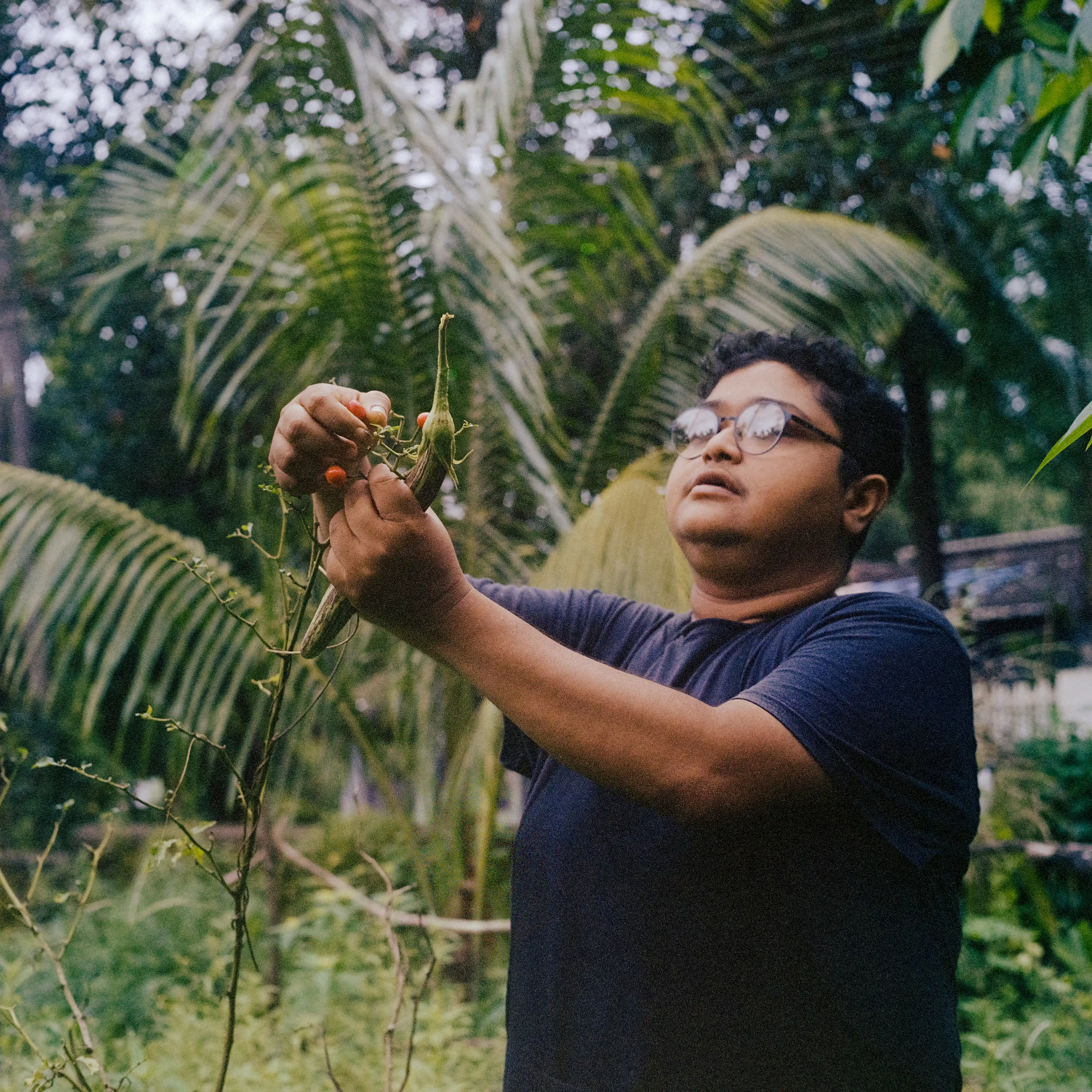
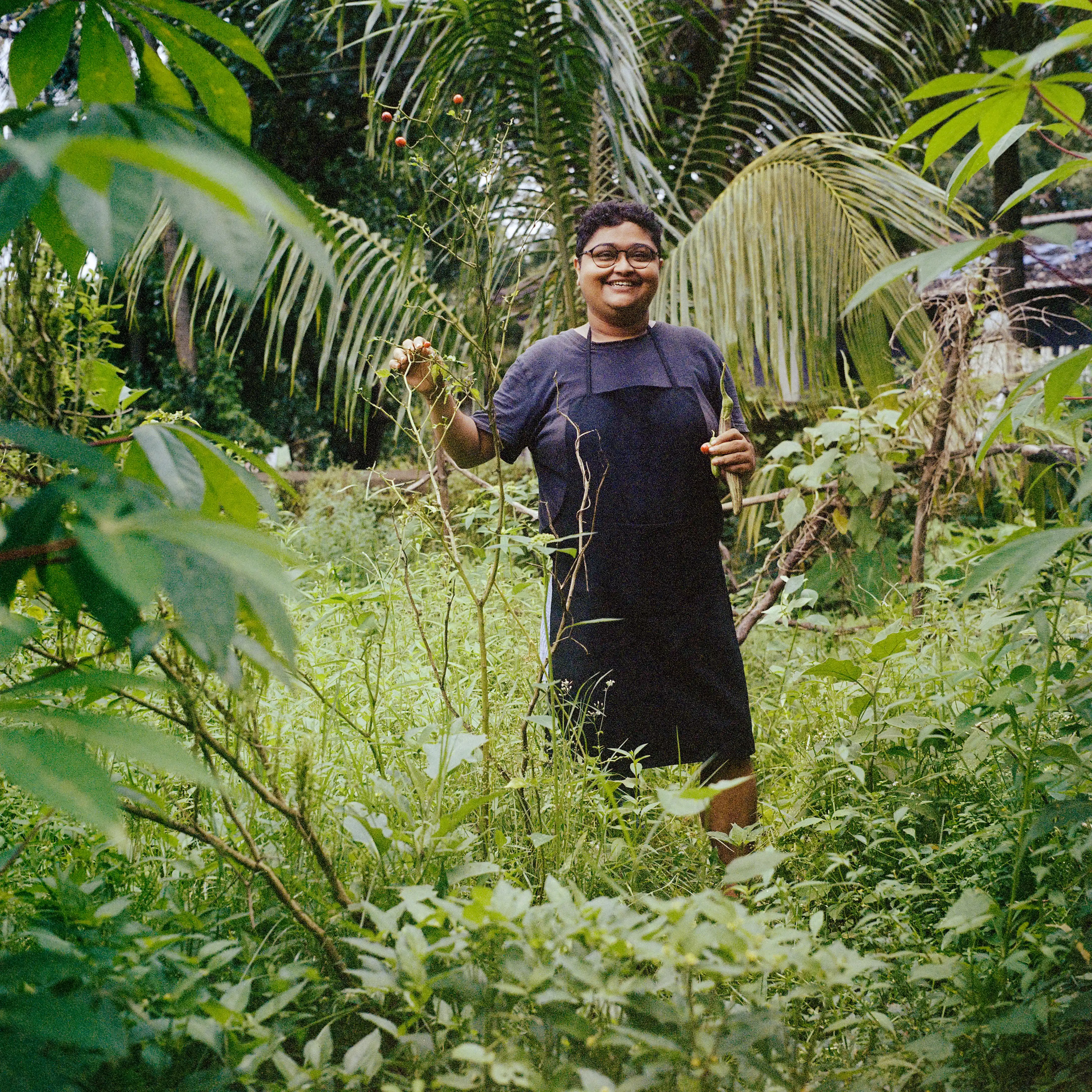
As she bends down to scour for greens, the rest of us begin to play another game in which we try to answer one another’s prompts as to the ripeness of the vegetables among the bushes through which we walk. “I spy something with a T,” says Boruah “Tomato!” says Dakpa, and Dastidar laughs. “Turmeric? That is over there….” she says, gesturing toward the large leaves close to the fence. She plucks skinny, tiger-striped eggplants to cook for lunch and points to small bhut jolokia peppers peeking from between the bushes, recognisable anywhere in their fierce redness, which she calls “dangerous little fruits”. As she walks out, hands full, she goes towards the kitchen again to cook us lunch. “In the first three months of lockdown, Shalini, our entire staff and I ate from this garden. This is what kept us going when the rest shut down.”
Spending a day with Dastidar evokes the feeling of being around a wise cousin; her wisdom about food is like a slow nudge towards new ways of looking at a familiar thing, a spectrum of influences that connect the past to the present, and even the future. In her presence, I am forced to think about everything I encounter, engage with what I am about to eat. Her knowledge of food varieties, her recognition of the labour of those that grow what we eat, are what make the restaurant “unconventional”, as some critics have called it. Dastidar disagrees with this, the way she does with any kind of label, which she calls “restrictive”. Earlier in the day, she had said that she didn’t want to be part of “any kind of brand”. “I don’t want to be included in some kind of niche category,” she says now. “We are trying to build a sustainable system of eating here, not use plastic; but to say that we are completely and totally just one kind of thing would be dishonest,” she adds. “There is a world outside, a society that runs the way it does – can I ignore that? No, I can’t, and I don’t want to. Often, people who engage in sustainability efforts are patronising and exclusive. I prefer not to preach, but to achieve something slowly.”
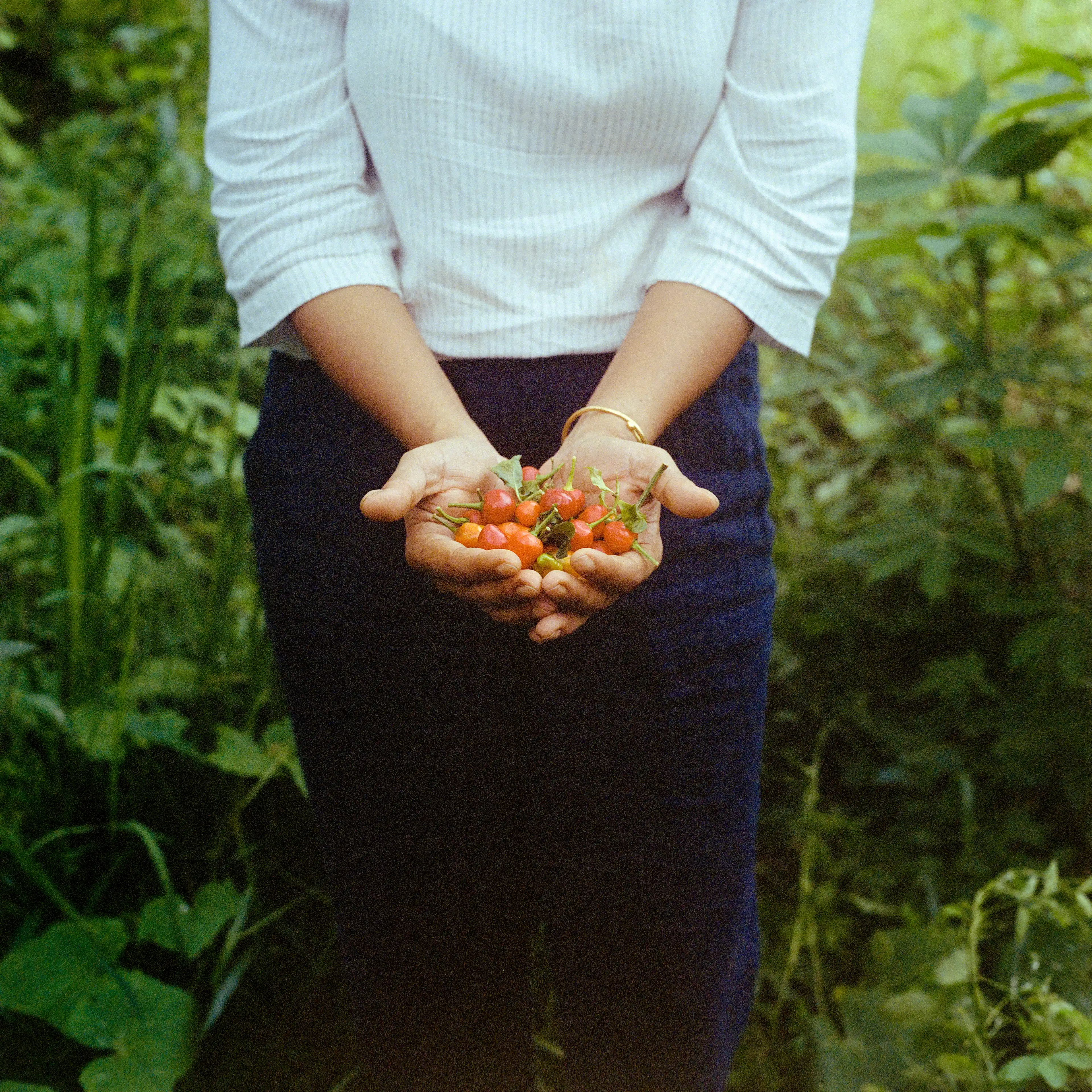
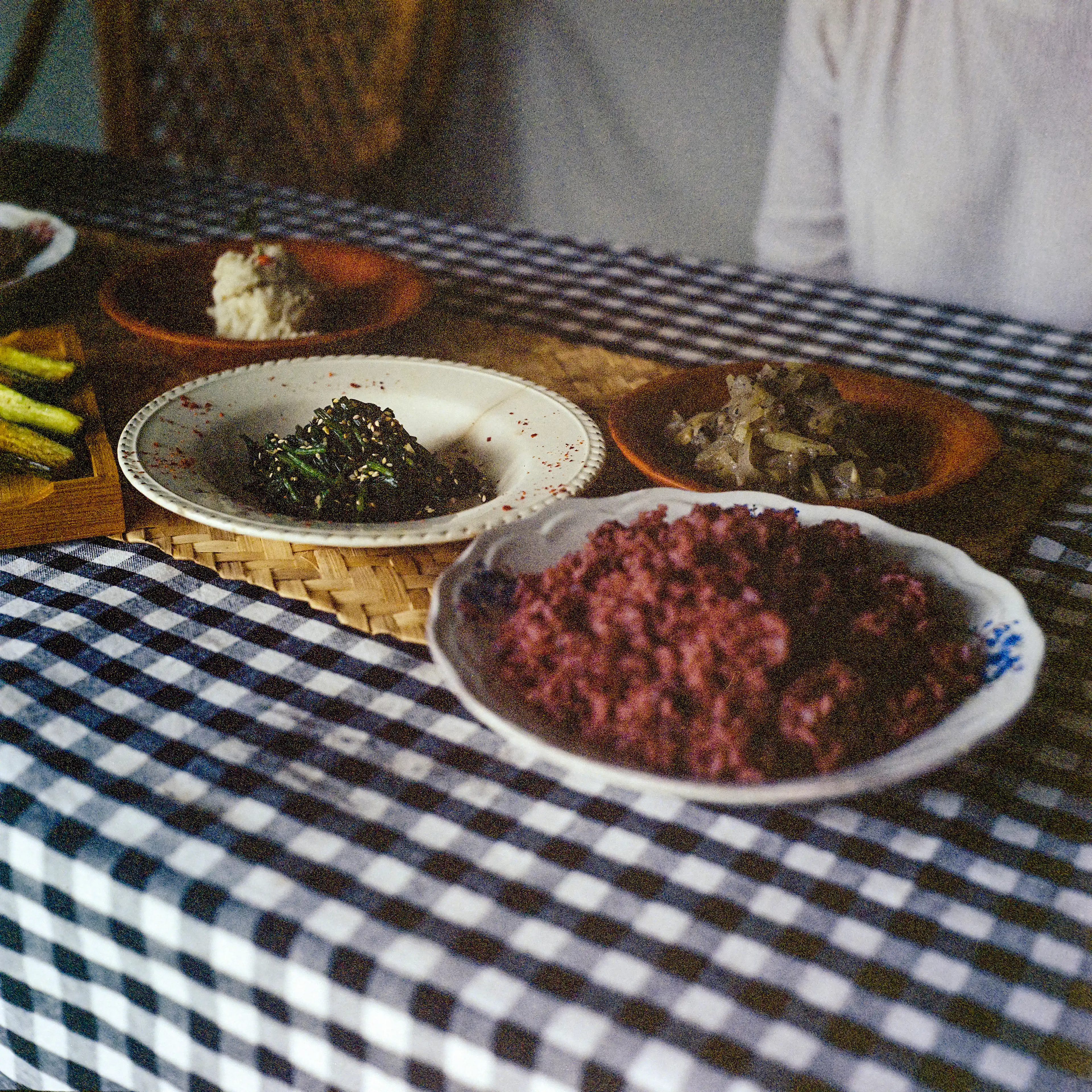
When our meal arrives, we drop everything and run to wash our hands and sit down as Dastidar waits near her kitchen and asks for our plates. “Anyone need salt?” She laughs. “Actually, I do. You know, Bengalis,” she says, as if amused by a secret joke. For lunch, Dastidar has rustled up pork with the madi – with chewy bits of skin on the meat, and the dish is tempered in everyone’s favourite bhut jolokia chillies. The tuber has also been steamed into a round mash with mustard oil; the aubergine from the garden has been sliced and cooked slightly until it turned golden brown. There is white rice, which Dastidar eats, and a bowl of mixtures of black rice grains from Maharashtra and Assam, which she pushes towards us. The meal is extraordinary, but also intriguing in its colours, tastes and textures. It is the balance Dastidar had mentioned before. Like at all tables of young people today, our conversation inevitably goes to the horrors unfolding in the country: the witch-hunt of Rhea Chakraborty, the arrest of activists from marginalised religions and caste backgrounds. We speak of our own privileges, and lack of them. She speaks of Hany Babu, one of her thesis advisors at university, who has just been arrested in the notorious Bhima Koregaon case. “It is a shame, a tragedy. In our country today, you may have freedom of speech – but not freedom after speech,” she says, referring to a quote by Idi Amin, the Ugandan dictator general, illustrating the dark times in India today.
This openness is the specialty of Dastidar. As a chef, she is also always critical, interacting with the world around her, and not remaining in bubbles of elite food cultures geared toward the country’s top five per cent. She represents a new generation of chefs who take pride in their heritage and use the plate to interrogate rather than appease. Dastidar is the kind of person who is easy to imagine anywhere. In a farm, bent over a new rice grain she has come across, or in transit through the world, surrounded by friends, eating whatever comes her way. As we eat, we talk continuously; the pork gets wiped out of its clay bowl, and the surprising star of the table – a white gourd that has been steamed and cooked with sesame seeds – gets fought over as it starts to disappear. “Lauki?” I keep saying (using the Hindi word for the vegetable), and she laughs. “How did you manage to do that to lauki?” She shrugs, bent over her plate, scooping spoonfuls of pork and rice. “It is possible to make anything delicious,” says Dastidar. “And besides, all food is good food. We are caught up in chasing hierarchies instead of actually addressing what we eat.” I ask about her plans for the restaurant and whether she sees that attitudes to ingredient-focused dining, like what she espouses, are changing. “I don’t know. I am not here to instruct anybody about what to do and how to eat. But this is what Shalini and I want to do, so, we do it,” she adds. “We want to initiate a thought, put it in the collective consciousness and let it take its own form. That may make a difference along the way.”